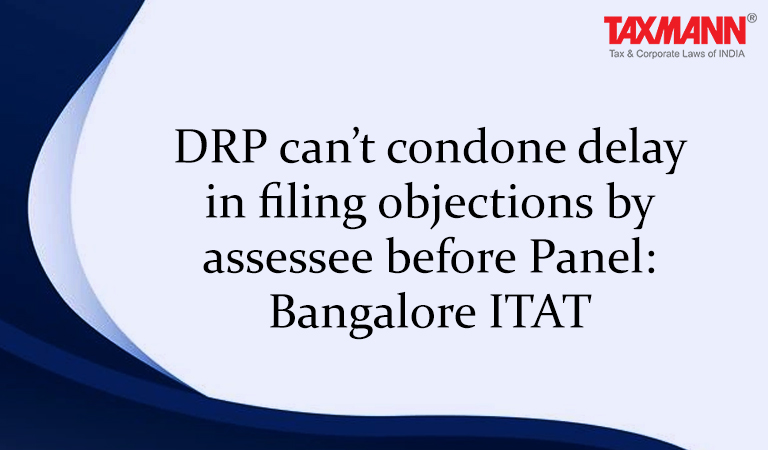DRP can’t condone delay in filing objections by assessee before Panel: Bangalore ITAT
- Blog|News|Income Tax|
- 2 Min Read
- By Taxmann
- |
- Last Updated on 6 January, 2022
Case Details: Lam Research (India) (P.) Ltd. v. ACIT [2021] 133 taxmann.com 279 (Bangalore - Trib.)
Judiciary and Counsel Details
-
- Chandra Poojari, Accountant Member and George George K, Judicial Member
- Ajit Tolani, CA and Darpan Kirpalani, Adv. for the Appellant.
- Ms. Neera Malhotra, CIT-DR for the Respondent.
Facts of the Case
Assessee was a private limited company, a wholly-owned subsidiary of Novellus Systems International Inc., USA. It provides computer development services and IT-enabled services for its Associate Enterprises (AEs) on a cost-plus markup basis.
During assessment proceedings, the matter was referred by the Assessing Officer (AO) to the Transfer Pricing Officer (TPO) to determine the ALP of the international transactions. The TPO made a transfer pricing adjustment, and after that, passed a draft assessment order.
The assessee filed objections before the Dispute Resolution Panel (DRP) with the delay of 3 days. Thus, DRP rejected the assessee’s objections by stating that it does not have power to condone the delay in filing the objections. Later, the final order was passed by AO. Aggrieved-assessee filed the instant appeal before the Tribunal.
ITAT Held
The Bangalore Tribunal held that the DRP derives its authorities and powers from section 144C of the Income-tax Act, and its procedures are governed by Income-tax (Dispute Resolution Panel) Rules, 2009. The provisions of the Act or Rule do not give any power to the DRP to condone the delay in filing the objections by the assessee before the Panel.
If the Legislature had intended to give such powers, it had been expressly implied as in the case of powers with the CIT(A) under section 249(3) and ITAT under section 253(5). Therefore, the DRP was right in rejecting the request of condonation of delay in filing the objection. This view is also endorsed by the Hon’ble Madras High Court in the case of Inno Estates (P.) Ltd. [2018] 96 taxmann.com 646 (Madras).
Case Review
-
- Inno Estates (P.) Ltd. v. DRP-2 [2018] 96 taxmann.com 646/258 Taxman 21/406 ITR 553 (Mad.) (para 6.2) followed.
List of Cases Referred to
-
- National Thermal Power Co. Ltd. v. CIT [1998] 229 ITR 383 (SC) (para 2.2)
- Yokogawa India Ltd. v. Asstt. CIT [IT (TP) Appeal Nos. 1715 & 692 (Bang.) of 2016, dated 11-3-2021] (para 4)
- Inno Estates (P.) Ltd. v. DRP-2 [2018] 96 taxmann.com 646/258 Taxman 21/406 ITR 553 (Mad.) (para 5)
- Himalayan Drug Co. v. Dy. CIT [2017] 84 taxmann.com 8 (Bang. – Trib) (para 5).
Disclaimer: The content/information published on the website is only for general information of the user and shall not be construed as legal advice. While the Taxmann has exercised reasonable efforts to ensure the veracity of information/content published, Taxmann shall be under no liability in any manner whatsoever for incorrect information, if any.

Taxmann Publications has a dedicated in-house Research & Editorial Team. This team consists of a team of Chartered Accountants, Company Secretaries, and Lawyers. This team works under the guidance and supervision of editor-in-chief Mr Rakesh Bhargava.
The Research and Editorial Team is responsible for developing reliable and accurate content for the readers. The team follows the six-sigma approach to achieve the benchmark of zero error in its publications and research platforms. The team ensures that the following publication guidelines are thoroughly followed while developing the content:
- The statutory material is obtained only from the authorized and reliable sources
- All the latest developments in the judicial and legislative fields are covered
- Prepare the analytical write-ups on current, controversial, and important issues to help the readers to understand the concept and its implications
- Every content published by Taxmann is complete, accurate and lucid
- All evidence-based statements are supported with proper reference to Section, Circular No., Notification No. or citations
- The golden rules of grammar, style and consistency are thoroughly followed
- Font and size that’s easy to read and remain consistent across all imprint and digital publications are applied








 CA | CS | CMA
CA | CS | CMA


